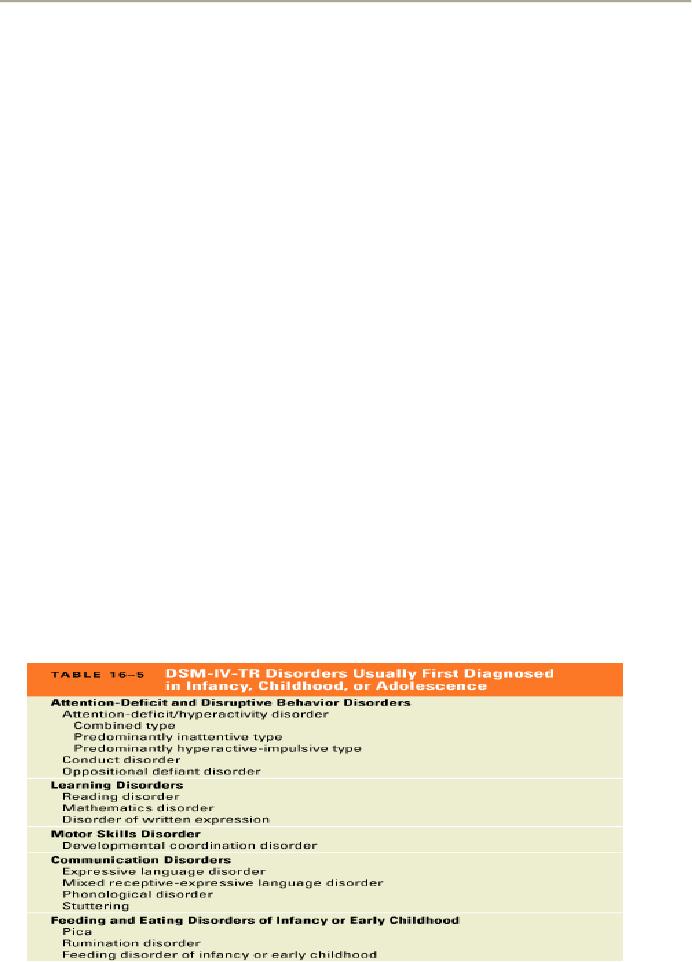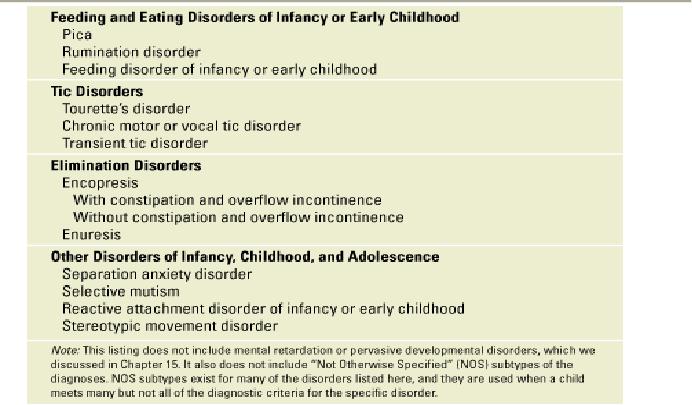 |
PSYCHOLOGICAL PROBLEMS OF CHILDHOOD:Kinds of Internalizing Disorders |
| << MENTAL RETARDATION AND DEVELOPMENTAL DISORDERS |
| LIFE CYCLE TRANSITIONS AND ADULT DEVELOPMENT:Aging >> |
Abnormal
Psychology PSY404
VU
Lesson
44
PSYCHOLOGICAL
PROBLEMS OF CHILDHOOD
Developmental
Psychopathology approach is absolutely
essential to disorders of childhood,
because
children
change rapidly during the
first 20 years of life.
Psychologists become concerned
only when a
child's
behavior deviates substantially
from developmental norms, behavior
that is typical for
children
of
a given age.
Psychological
problems that commonly begin during
childhood are listed in the DSM-IV-TR
category
Disorders
Usually First Diagnosed in Infancy,
Childhood, or Adolescence.
Other
than mental retardation and
pervasive developmental disorders, the
most important disorders
in
this
category are the various externalizing
disorders.
Two
kinds of disorders
1-
Externalizing Disorders
2-
Internalizing Disorders
We
have covered the externalizing disorders
in lecture no 43
1-
Externalizing Disorders
Externalizing
disorders create difficulties
for the child's external world.
Externalizing disorders
are
characterized
by children's failure to control their
behavior according to the expectations of
parents,
peers,
teachers, and/or legal
authorities--for example, as a result of
hyperactive behavior or conduct
problems.
Kinds
of Pervasive Developmental
Disorder
i.
Autistic Disorder
ii.
Attention Deficit Hyperactivity
Disorder (ADHD)
iii.
Oppositional Deficit Disorder
(ODD)
iv.
Conduct Disorder
v.
Asperger's Disorder
vi.
Childhood Disintegrative Disorder
vii.
Rett's Disorder
Symptoms
of Externalizing Disorders
Many
externalizing symptoms involve violations
of age-appropriate social rules,
including disobeying
parents
or teachers, violating social or
peer group norms (e.g.,
annoying others), and perhaps
violating
the
law.
Some
misconduct is normal, perhaps even
healthy, for children.
However,
the rule violations in externalizing disorders
are not trivial and
are far from
"cute."
Externalizing
behavior is a far greater
concern when it is frequent, intense,
lasting, and
pervasive.
2-
Internalizing Disorders
Internalizing
disorders are psychological
problems that primarily affect the
child's internal world--for
example,
excessive anxiety or sadness.
DSM-IV-TR
does not list internalizing
disorders as separate psychological
disorders of childhood;
rather,
the manual notes that
children may qualify for
many "adult" diagnoses, such
as anxiety or mood
disorders.
Symptoms
of Internalizing Disorders
Children's
internalizing symptoms include sadness,
fears, and somatic
complaints, as well as
other
indicators
of mood and anxiety disorders--for
example, feeling worthless or
tense.
219

Abnormal
Psychology PSY404
VU
DSM-IV-TR
does not have a separate
category for children's internalizing
disorders, but the
manual
does
identify some unique ways in
which children experience the
symptoms.
In
assessing children's internalizing
problems, mental health professionals
must obtain
information
from
multiple
informants--parents,
teachers, and the children
themselves.
When
assessing children directly,
child clinical psychologists are
sensitive to different signs
that may be
indicative
of depression at different
ages.
Depression
in children and adolescents
often is comorbid both with
externalizing problems and
with
anxiety.
Three
findings from fear research
are important to note.
�
First,
children develop different fears
for the first time at different
ages, and the onset of
new
fears
may be sudden and have no
apparent cause in the child's
environment.
�
A
second finding is that some
fears, particularly fears of
uncontrollable events such as
disasters,
are
both common and relatively
stable across different
ages.
�
Third,
many other fears, especially
specific ones like fears of
monsters or normal worries
about
death,
become less frequent as
children grow older.
Kinds
of Internalizing Disorders
1-
DSM-IV-TR
contains a diagnosis for
separation
anxiety disorder,
which is defined by
symptoms
such
as persistent and excessive
worry for the safety of an
attachment figure, fears of getting lost
or
being
kidnapped, nightmares with separation
themes, and refusal to be
alone.
Separation
anxiety disorder is especially problematic when it
interferes with school
attendance.
2-
School refusal, also
known as school
phobia, is
characterized by an extreme reluctance to
go to school,
and
is accompanied by various symptoms of
anxiety, such as stomachaches and
headaches.
Children
with internalizing or externalizing
problems often have troubled
peer relationships.
In
1896, the psychologist Lightner Witmer
established the first psychological
clinic for children in
the
United
States.
Despite
the early origins of child clinical
psychology, children were
largely ignored in early
classifications
of mental disorders.
DSM-I
contained only two separate
diagnoses for children, and
DSM-II listed only seven
childhood
disorders.
DSM-III
recognized a much wider range of
childhood disorders, and in
fact, contained a proliferation
of
diagnostic categories, 40 in all.
Although
laudable, the new effort was
overly ambitious.
Many
of the new diagnoses were
severely criticized and subsequently
were dropped.
220

Abnormal
Psychology PSY404
VU
3-
Pica is the
persistent eating of nonnutritive
substances, such as paint or
dirt.
Many
infants and toddlers put nonnutritive
substances in their mouths,
but the feeding disorder pica is
rarely
diagnosed, except among mentally
retarded children.
4-
Rumination disorder,
the
repeated regurgitation and
rechewing of food, is another
infrequent
feeding
disorder.
5-
Tourette's disorder is a
rare problem (4 to 5 cases
per 10,000 people) that is
characterized by
repeated
motor and verbal
tics.
6-
Stereotypic movement disorder is self-stimulation
or self-injurious behavior that is
serious enough
to
require treatment, as may occur in mental
retardation or pervasive developmental
disorder.
7-
Selective mutism involves
the consistent failure to speak in
certain social situations
(for example, in
school)
while speech is unrestricted in
other situations (for
example, at home).
8-
Reactive attachment disorder is another
rarely diagnosed problem, although it
may be more
prevalent
than we would hope.
Reactive
attachment disorder is characterized by
severely disturbed and developmentally
inappropriate
social
relationships.
9-
Encopresis and enuresis are
common problems. The terms
refer, respectively, to
inappropriately
controlled
defecation and urination.
Eating
disorders have increased
dramatically since thinness
has become a national
obsession.
10-
Victims
of anorexia
nervosa so
relentlessly pursue extreme
thinness that they may
starve
themselves
to death.
11-
Victims
of bulimia
nervosa go on
frequent eating binges, then
take laxatives or force themselves
to
vomit
to keep from gaining weight. These
eating disorders, which
share many important
features, are
disproportionately
prevalent among adolescent girls
and young women.
Primary
hypersomnia is
excessive sleepiness characterized by
prolonged or daytime sleep,
lasting at
least
a month and significantly interfering
with life
functioning.
Primary
hypersomnia is similar to
narcolepsy,
irresistible
attacks of refreshing sleep,
lasting at least 3
months.
12-
Breathing-related sleep disorder
involves
the disruption in sleep due to breathing
problems such
as
the temporary obstruction of the respiratory
airway.
The
parasomnias
include nightmare
disorder, sleep terror disorder, and
sleepwalking disorder.
13-
People
with nightmare disorder are frequently
awakened by terrifying
dreams.
221
Abnormal
Psychology PSY404
VU
14-
Sleep
terror disorder also involves
abrupt awakening from sleep,
typically with a scream, but
it
differs
from nightmare disorder in important
respects.
15-
Sleepwalking
disorder involves rising from the bed
during sleep and walking
about in a generally
unresponsive
state.
Occasional
episodes of sleepwalking are
fairly common, especially
among children.
Like
all sleep disorders,
sleepwalking disorder tends to be
diagnosed only if it causes significant
distress
or
impairs the person's ability to
function.
Many
listed childhood disorders not in fact
mental disorders.
Child's
behavior is intimately linked
with the family, school, and
peer contexts.
Because
of this, some experts have
suggested that diagnosing
individual children is misleading
and
misguided.
Instead,
children's psychological problems could be
classified within the context of
key relationships,
particularly
the family.
Frequency
of Internalizing Disorders
�
The
prevalence of externalizing disorders
generally decreases as children grow
older, but the
opposite
is true for internalizing
disorders.
�
Suicide
is the leading cause of death
among teenagers, trailing
only automobile accidents
and
natural
causes.
�
In
comparison to adult suicide
attempts, suicide attempts
among adolescents are more
impulsive,
more
likely to follow a family
conflict, and are more
often motivated by anger rather
than
depression.
�
Evidence
simply is lacking or inadequate on the development of
many other
psychological
problems
of childhood.
Treatment
of Internalizing Disorders
�
Relatively
few treatments for anxiety or mood
disorders have been developed or
studied specifically
as
they apply to children.
�
For
example, medications known to
alleviate depression in adults
have rarely been studied
among
children
and adolescents, and may be
no more effective than placebos in
treating their depression.
�
Researchers
already have begun to
correct the neglect of treatment research
on children's
internalizing
disorders.
�
Some
forms of cognitive behavior therapy and
interpersonal therapy show promise for
treating
children's
depression, and cognitive
behavior therapy and family therapy
have produced positive
results
in treating children's anxiety.
222
Table of Contents:
- ABNORMAL PSYCHOLOGY:PSYCHOSIS, Team approach in psychology
- WHAT IS ABNORMAL BEHAVIOR:Dysfunction, Distress, Danger
- PSYCHOPATHOLOGY IN HISTORICAL CONTEXT:Supernatural Model, Biological Model
- PSYCHOPATHOLOGY IN HISTORICAL CONTEXT:Free association, Dream analysis
- PSYCHOPATHOLOGY IN HISTORICAL CONTEXT:Humanistic Model, Classical Conditioning
- RESEARCH METHODS:To Read Research, To Evaluate Research, To increase marketability
- RESEARCH DESIGNS:Types of Variables, Confounding variables or extraneous
- EXPERIMENTAL REASEARCH DESIGNS:Control Groups, Placebo Control Groups
- GENETICS:Adoption Studies, Twin Studies, Sequential Design, Follow back studies
- RESEARCH ETHICS:Approval for the research project, Risk, Consent
- CAUSES OF ABNORMAL BEHAVIOR:Biological Dimensions
- THE STRUCTURE OF BRAIN:Peripheral Nervous System, Psychoanalytic Model
- CAUSES OF PSYCHOPATHOLOGY:Biomedical Model, Humanistic model
- CAUSES OF ABNORMAL BEHAVIOR ETIOLOGICAL FACTORS OF ABNORMALITY
- CLASSIFICATION AND ASSESSMENT:Reliability, Test retest, Split Half
- DIAGNOSING PSYCHOLOGICAL DISORDERS:The categorical approach, Prototypical approach
- EVALUATING SYSTEMS:Basic Issues in Assessment, Interviews
- ASSESSMENT of PERSONALITY:Advantages of MMPI-2, Intelligence Tests
- ASSESSMENT of PERSONALITY (2):Neuropsychological Tests, Biofeedback
- PSYCHOTHERAPY:Global Therapies, Individual therapy, Brief Historical Perspective
- PSYCHOTHERAPY:Problem based therapies, Gestalt therapy, Behavioral therapies
- PSYCHOTHERAPY:Ego Analysis, Psychodynamic Psychotherapy, Aversion Therapy
- PSYCHOTHERAPY:Humanistic Psychotherapy, Client-Centered Therapy, Gestalt therapy
- ANXIETY DISORDERS:THEORIES ABOUT ANXIETY DISORDERS
- ANXIETY DISORDERS:Social Phobias, Agoraphobia, Treating Phobias
- MOOD DISORDERS:Emotional Symptoms, Cognitive Symptoms, Bipolar Disorders
- MOOD DISORDERS:DIAGNOSIS, Further Descriptions and Subtypes, Social Factors
- SUICIDE:PRECIPITATING FACTORS IN SUICIDE, VIEWS ON SUICIDE
- STRESS:Stress as a Life Event, Coping, Optimism, Health Behavior
- STRESS:Psychophysiological Responses to Stress, Health Behavior
- ACUTE AND POSTTRAUMATIC STRESS DISORDERS
- DISSOCIATIVE AND SOMATOFORM DISORDERS:DISSOCIATIVE DISORDERS
- DISSOCIATIVE and SOMATOFORM DISORDERS:SOMATOFORM DISORDERS
- PERSONALITY DISORDERS:Causes of Personality Disorders, Motive
- PERSONALITY DISORDERS:Paranoid Personality, Schizoid Personality, The Diagnosis
- ALCOHOLISM AND SUBSTANCE RELATED DISORDERS:Poly Drug Use
- ALCOHOLISM AND SUBSTANCE RELATED DISORDERS:Integrated Systems
- SCHIZOPHRENIA:Prodromal Phase, Residual Phase, Negative symptoms
- SCHIZOPHRENIA:Related Psychotic Disorders, Causes of Schizophrenia
- DEMENTIA DELIRIUM AND AMNESTIC DISORDERS:DELIRIUM, Causes of Delirium
- DEMENTIA DELIRIUM AND AMNESTIC DISORDERS:Amnesia
- MENTAL RETARDATION AND DEVELOPMENTAL DISORDERS
- MENTAL RETARDATION AND DEVELOPMENTAL DISORDERS
- PSYCHOLOGICAL PROBLEMS OF CHILDHOOD:Kinds of Internalizing Disorders
- LIFE CYCLE TRANSITIONS AND ADULT DEVELOPMENT:Aging